Friedenstein Castle on:
[Wikipedia]
[Google]
[Amazon]
 Friedenstein Palace (german: Schloss Friedenstein) is an early Baroque palace built in the mid-17th century by
Friedenstein Palace (german: Schloss Friedenstein) is an early Baroque palace built in the mid-17th century by


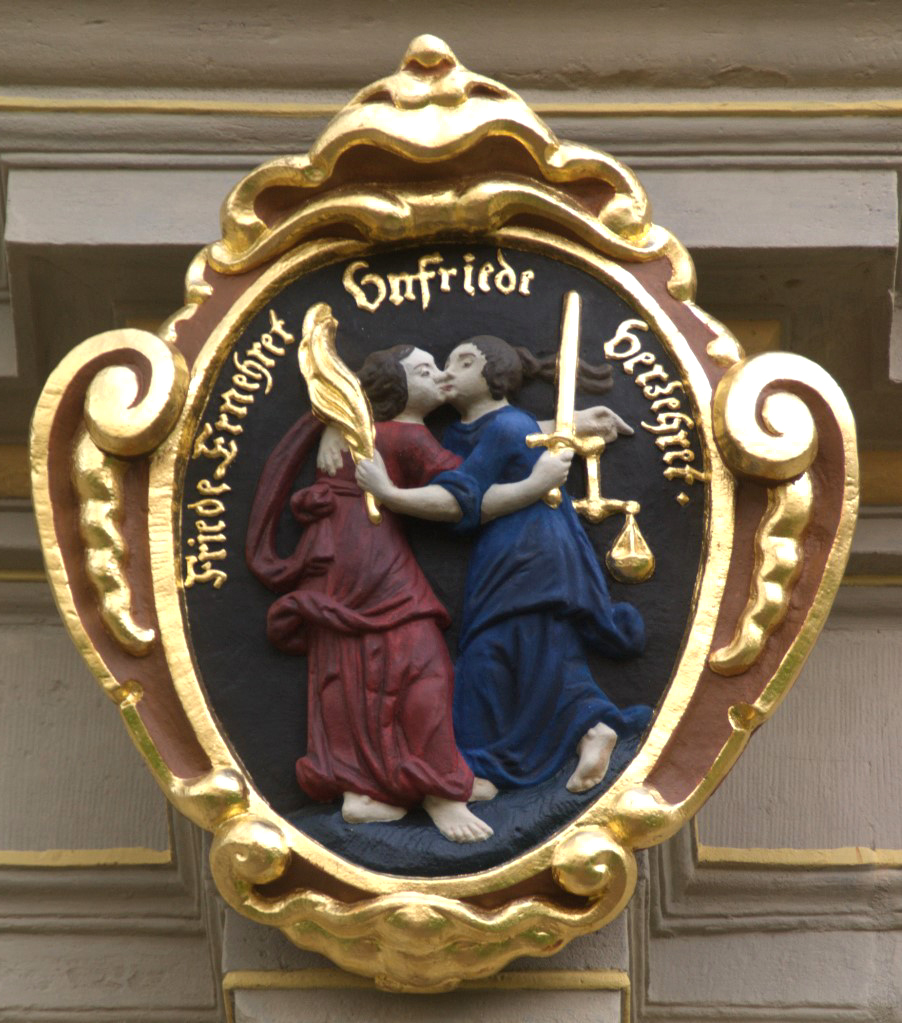
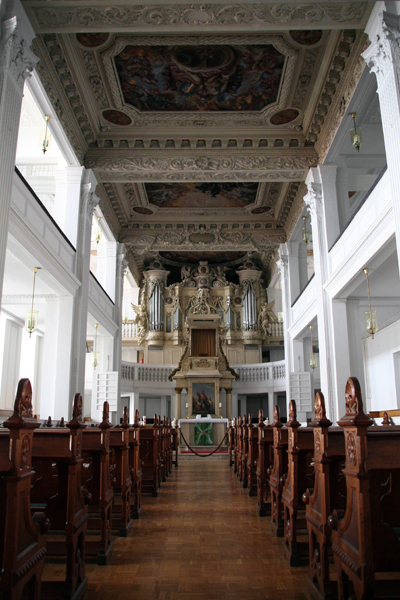
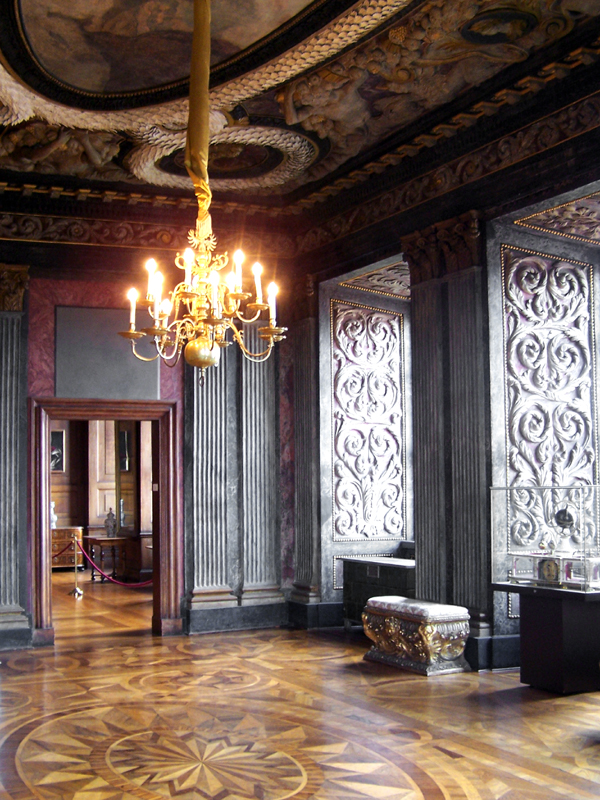
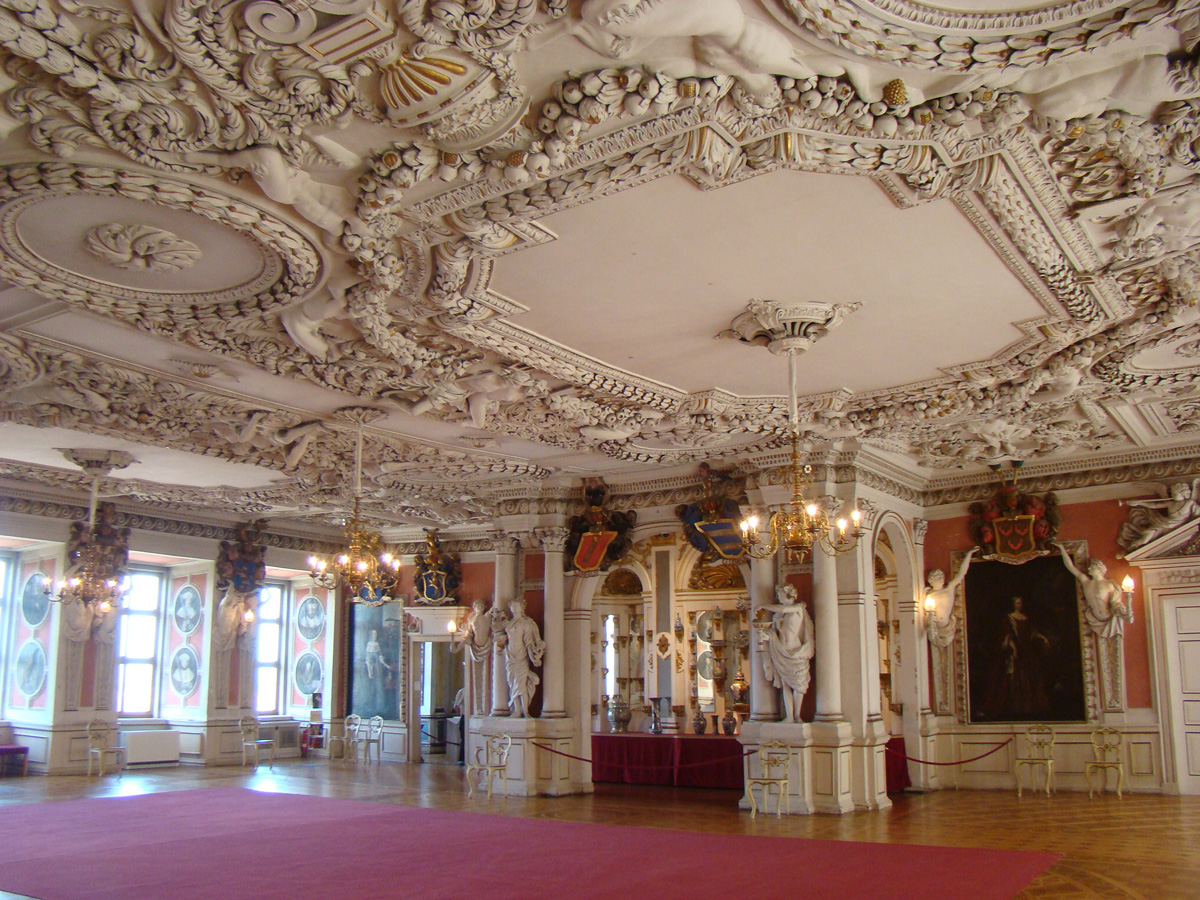 The castle built for Ernst I was constructed according to general principles favoured by Protestant rulers in the 17th century. It took the form of a so-called "sub-ordinated" palace, meaning that the four wings are not on an equal footing but that there is one dominating main wing. At ''Friedenstein'' that is the four-story north wing, facing the town. The two side wings have three floors (but end in the four-story towers or pavilions) and the final wing had just one floor. Initially, all the state apartments were housed in the four-storied sections of the palace.
The palace dominates the town by its sheer size: the main wing is 100 metres long, the two side wings are 140 metres long. Although the interior of the palace has been significantly altered since the time of Ernst I, the exterior has remained largely unchanged. The simple, unadorned exterior was originally selected to contrast with the palaces of Catholic princes, which at the time were still mostly influenced by the elaborate
The castle built for Ernst I was constructed according to general principles favoured by Protestant rulers in the 17th century. It took the form of a so-called "sub-ordinated" palace, meaning that the four wings are not on an equal footing but that there is one dominating main wing. At ''Friedenstein'' that is the four-story north wing, facing the town. The two side wings have three floors (but end in the four-story towers or pavilions) and the final wing had just one floor. Initially, all the state apartments were housed in the four-storied sections of the palace.
The palace dominates the town by its sheer size: the main wing is 100 metres long, the two side wings are 140 metres long. Although the interior of the palace has been significantly altered since the time of Ernst I, the exterior has remained largely unchanged. The simple, unadorned exterior was originally selected to contrast with the palaces of Catholic princes, which at the time were still mostly influenced by the elaborate
 Located in the west pavilion, the ''Schlosstheater'' was built in 1681-87 by Caspar Lindemann and Hans Hoffmann. It is one of the oldest still operating theatres in Germany.
Today, the theatre is named after its best-known ''Direktor''. In 1774, an actor group led by Conrad (or Konrad) Ekhof, called "the father of German acting", came from Weimar to Gotha. Ekhof began working at the ''Schlosstheater'' and became ''Direktor'' of the newly created "court theatre" while acting in many plays himself. Having turned it into one of the leading theatres in Germany, after his death in 1778 the fame of the theatre declined rapidly.
The current appearance of the theatre dates mostly to renovation in 1774/75, although the ceiling (looking like
Located in the west pavilion, the ''Schlosstheater'' was built in 1681-87 by Caspar Lindemann and Hans Hoffmann. It is one of the oldest still operating theatres in Germany.
Today, the theatre is named after its best-known ''Direktor''. In 1774, an actor group led by Conrad (or Konrad) Ekhof, called "the father of German acting", came from Weimar to Gotha. Ekhof began working at the ''Schlosstheater'' and became ''Direktor'' of the newly created "court theatre" while acting in many plays himself. Having turned it into one of the leading theatres in Germany, after his death in 1778 the fame of the theatre declined rapidly.
The current appearance of the theatre dates mostly to renovation in 1774/75, although the ceiling (looking like
 In 1707/08, a
In 1707/08, a 
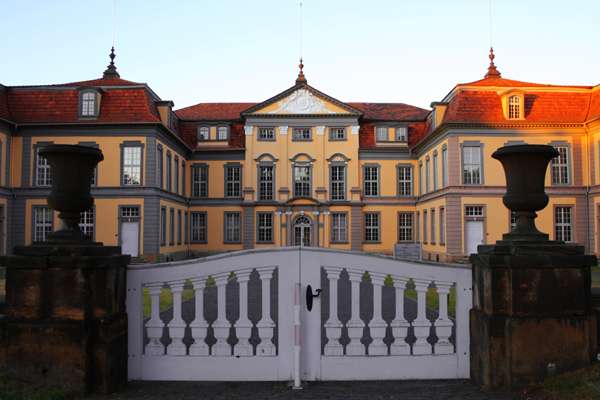

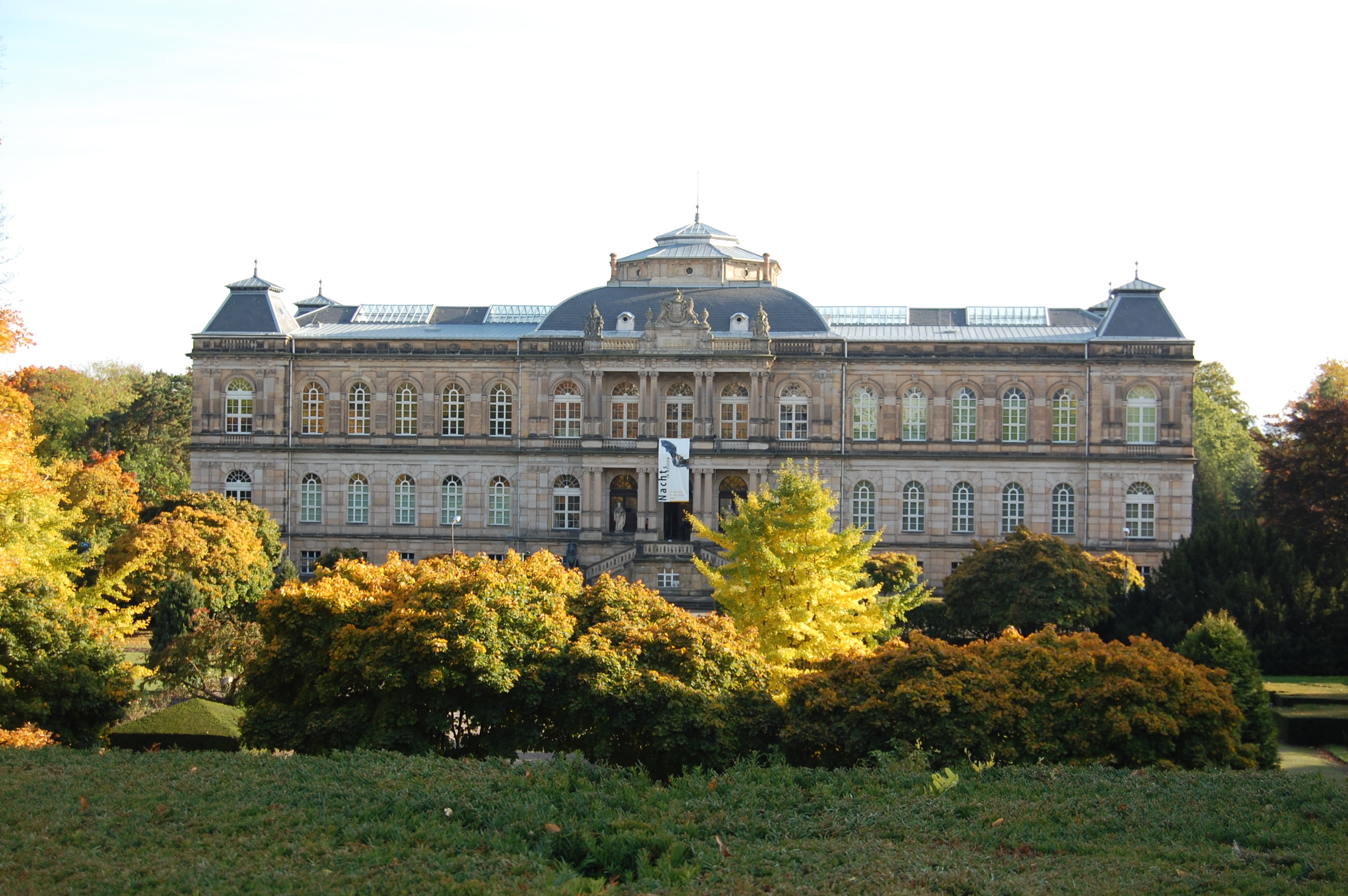 The axis between ''Friedrichsthal'' and ''Friedenstein'' was turned into the ''Orangeriegarten'' between 1747 and 1774, designed by . This is the oldest part of the gardens still in existence today. By the time it was finished, however, this type of garden had become unfashionable.
After 1767, Ernst II combined the individual gardens into a single ensemble. The bastions were demolished and new sections added:
* The
The axis between ''Friedrichsthal'' and ''Friedenstein'' was turned into the ''Orangeriegarten'' between 1747 and 1774, designed by . This is the oldest part of the gardens still in existence today. By the time it was finished, however, this type of garden had become unfashionable.
After 1767, Ernst II combined the individual gardens into a single ensemble. The bastions were demolished and new sections added:
* The

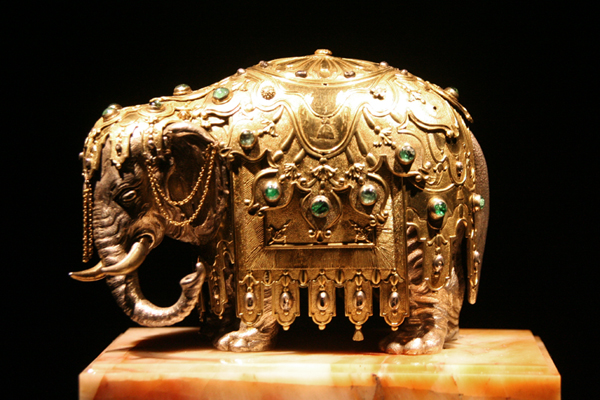 The palace houses the ''Schlossmuseum'' (state apartments), ''Museum der Natur'' (natural history) and the "Historical Museum Gotha" in the north and west wing, the ' in the west wing and the ' in the east wing.
The ''Schlossmuseum'' currently combines the Baroque and neoclassical state apartments, the Ducal ''Kunstkammer'', the ''Neue Münzkabinett'' (numismatic collection) and the ''Ekhof-Theater''.
The gallery of paintings has been moved to the New Museum building outside the palace itself. This reorganisation is part of the general overhaul of the museums that began in 2010 under the label ''Barockes Universum Gotha'' ("Baroque universe Gotha").
The palace houses the ''Schlossmuseum'' (state apartments), ''Museum der Natur'' (natural history) and the "Historical Museum Gotha" in the north and west wing, the ' in the west wing and the ' in the east wing.
The ''Schlossmuseum'' currently combines the Baroque and neoclassical state apartments, the Ducal ''Kunstkammer'', the ''Neue Münzkabinett'' (numismatic collection) and the ''Ekhof-Theater''.
The gallery of paintings has been moved to the New Museum building outside the palace itself. This reorganisation is part of the general overhaul of the museums that began in 2010 under the label ''Barockes Universum Gotha'' ("Baroque universe Gotha").
Official Website
Forschungszentrum Gotha of Erfurt University (German)
Freundeskreis Friedenstein (German)
Stiftung Friedenstein (German)
Article about the palace from August 2010 (German)
{{Authority control House of Saxe-Coburg and Gotha House of Saxe-Gotha-Altenburg Museums in Thuringia Castles in Thuringia Royal residences in Germany
 Friedenstein Palace (german: Schloss Friedenstein) is an early Baroque palace built in the mid-17th century by
Friedenstein Palace (german: Schloss Friedenstein) is an early Baroque palace built in the mid-17th century by Ernest I, Duke of Saxe-Gotha
Ernest I, called "Ernest the Pious" (25 December 1601 – 26 March 1675), was a duke of Saxe-Gotha and Saxe-Altenburg. The duchies were later merged into Saxe-Gotha-Altenburg.
He was the ninth but sixth surviving son of Johann II, Duke of S ...
at Gotha
Gotha () is the fifth-largest city in Thuringia, Germany, west of Erfurt and east of Eisenach with a population of 44,000. The city is the capital of the district of Gotha and was also a residence of the Ernestine Wettins from 1640 until the ...
, Thuringia
Thuringia (; german: Thüringen ), officially the Free State of Thuringia ( ), is a state of central Germany, covering , the sixth smallest of the sixteen German states. It has a population of about 2.1 million.
Erfurt is the capital and lar ...
, Germany
Germany, officially the Federal Republic of Germany (FRG),, is a country in Central Europe. It is the most populous member state of the European Union. Germany lies between the Baltic and North Sea to the north and the Alps to the sou ...
. In Germany, ''Friedenstein'' was one of the largest palaces of its time and one of the first Baroque palaces ever built. ''Friedenstein'' served as the main seat of the Dukes of Saxe-Gotha and later as one of the residences of the Dukes of Saxe-Coburg and Gotha, closely linked with the Royal Family of Great Britain through the marriage of Queen Victoria
Victoria (Alexandrina Victoria; 24 May 1819 – 22 January 1901) was Queen of the United Kingdom of Great Britain and Ireland from 20 June 1837 until her death in 1901. Her reign of 63 years and 216 days was longer than that of any previ ...
and Prince Albert
Albert may refer to:
Companies
* Albert (supermarket), a supermarket chain in the Czech Republic
* Albert Heijn, a supermarket chain in the Netherlands
* Albert Market, a street market in The Gambia
* Albert Productions, a record label
* Alber ...
. The final two ruling Dukes were both princes of the United Kingdom.
The palace complex today houses several museums. It is also notable for hosting the , one of the oldest theatres in operation in Germany, still featuring the original Baroque machinery for changing the scenery
Theatrical scenery is that which is used as a setting for a theatrical production. Scenery may be just about anything, from a single chair to an elaborately re-created street, no matter how large or how small, whether the item was custom-made or ...
.
History
Earlier structures
The site where ''Friedenstein'' stands today, dominating the town of Gotha and its surroundings, was previously occupied by ''Grimmenstein Castle''. It was first mentioned in 1316 and rebuilt in 1531-43 when it was also fortified in accordance with the changed requirements for a fortress in the age of gunpowder. In 1547, the Ernestine branch of theHouse of Wettin
The House of Wettin () is a dynasty of Germany, German monarch, kings, Prince Elector, prince-electors, dukes, and counts that once ruled territories in the present-day German states of Saxony, Saxony-Anhalt and Thuringia. The dynasty is one of ...
as members of the Protestant Schmalkaldic League
The Schmalkaldic League (; ; or ) was a military alliance of Lutheran princes within the Holy Roman Empire during the mid-16th century.
Although created for religious motives soon after the start of the Reformation, its members later came to ...
had lost the Battle of Mühlberg
The Battle of Mühlberg took place near Mühlberg in the Electorate of Saxony in 1547, during the Schmalkaldic War. The Catholic princes of the Holy Roman Empire led by the Holy Roman Emperor Charles V decisively defeated the Lutheran Schma ...
against the Catholic forces of Emperor Charles V
Charles V, french: Charles Quint, it, Carlo V, nl, Karel V, ca, Carles V, la, Carolus V (24 February 1500 – 21 September 1558) was Holy Roman Emperor and Archduke of Austria from 1519 to 1556, King of Spain ( Castile and Aragon) fr ...
. As a result, Johann Friedrich I, Kurfürst von Sachsen (John Frederick I) was stripped of his title as "Elector of Saxony" (''Kurwürde''). Imperial forces blew up the fortifications of ''Grimmenstein'' but left the castle itself largely intact. It was rebuilt in 1552-54. However, in 1567 the fortress was almost completely razed as a result of the attempt of Johann Friedrich II (John Frederick II) to regain the ''Kurwürde'' by force of arms.
Construction
In 1640,Ernest I, Duke of Saxe-Gotha
Ernest I, called "Ernest the Pious" (25 December 1601 – 26 March 1675), was a duke of Saxe-Gotha and Saxe-Altenburg. The duchies were later merged into Saxe-Gotha-Altenburg.
He was the ninth but sixth surviving son of Johann II, Duke of S ...
, also known as ''Ernst der Fromme'' ("Ernest the Pious"), first ruler of the newly created Duchy of Saxe-Gotha
Saxe-Gotha (german: Sachsen-Gotha) was one of the Saxon duchies held by the Ernestine branch of the Wettin dynasty in the former Landgraviate of Thuringia. The ducal residence was erected at Gotha.
History
The duchy was established in 1640, when ...
, settled on Gotha as the site for his ''Residenz
Residenz () is a German word for "place of living", now obsolete except in the formal sense of an official residence. A related term, Residenzstadt, denotes a city where a sovereign ruler resided, therefore carrying a similar meaning as the modern ...
''. Gotha at the time was the largest town in the Duchy. In 1641/42 work began on the park, followed by construction of the palace itself in 1643. In naming the castle ''Friedenstein'' (literally "peace-rock"), Ernst made a point of drawing a clear line between this new palace and the warlike history of its predecessor. In addition, with the Thirty Years War
The Thirty Years' War was one of the longest and most destructive conflicts in European history, lasting from 1618 to 1648. Fought primarily in Central Europe, an estimated 4.5 to 8 million soldiers and civilians died as a result of battle ...
still ongoing, the name also expressed a desire for peace after decades of warfare.
Based on plans by (1600-1663), (1601-1679) was in charge of building the castle. When it was finished in 1656, ''Friedenstein'' was the first ever ''Residenz'' in the Baroque style built on German soil that was completed during the lifetime of the ruler who ordered it. To justify the expense of such a vast structure, Ernest explicitly referred to the need to accommodate the administration for the new Duchy.
In July 1655, work began on fortifying the castle. By 1672, four bastion
A bastion or bulwark is a structure projecting outward from the curtain wall of a fortification, most commonly angular in shape and positioned at the corners of the fort. The fully developed bastion consists of two faces and two flanks, with fi ...
s had been completed. The outer works were finished by 1687 and, beginning in 1663, the town of Gotha was also fortified. In 1672, the House of Saxe-Altenburg ended and most of the Duchy passed to Ernst, who now was ruler of Saxe-Gotha-Altenburg
Saxe-Gotha-Altenburg () was a duchy ruled by the Ernestine branch of the House of Wettin in today's Thuringia, Germany. The extinction of the line in 1825 led to a major re-organisation of the Thuringian states.
History
In 1640 the sons of t ...
. Although the Duchy now had two ''Residenzen'', Gotha was by far the more important one.
However, Ernst was unwilling to exclude any of his surviving sons from his heritage. So after his death in 1675, the Duchy was split in 1680/81 into seven separate territories: Saxe-Gotha-Altenburg, Saxe-Coburg
Saxe-Coburg (german: Sachsen-Coburg) was a duchy held by the Ernestine branch of the Wettin dynasty in today's Bavaria, Germany.
History
Ernestine Line
When Henry IV, Count of Henneberg – Schleusingen, died in 1347, the possessions of t ...
, Saxe-Meiningen
Saxe-Meiningen (; german: Sachsen-Meiningen ) was one of the Saxon duchies held by the Ernestine line of the Wettin dynasty, located in the southwest of the present-day German state of Thuringia.
Established in 1681, by partition of the Ernest ...
, Saxe-Römhild
Saxe-Römhild (German: ''Sachsen-Römhild'') was an Ernestine duchy in the southern foothills of the Thuringian Forest. It existed for only 30 years, from 1680 to 1710.
History
After the Duke of Saxe-Gotha, Ernest the Pious, died on 26 Marc ...
, Saxe-Eisenberg
The Duchy of Saxe-Eisenberg was one of the Saxon Duchies held by the Ernestine line of the Wettin Dynasty.
History
Established in 1680 for Christian, fifth son of Ernest I, Duke of Saxe-Gotha, the Duchy consisted of Eisenberg and the towns ...
, Saxe-Hildburghausen
Saxe-Hildburghausen () was an Ernestine duchy in the southern side of the present State of Thuringia in Germany. It existed from 1680 to 1826 but its name and borders are currently used by the District of Hildburghausen.
History
After the Duk ...
and Saxe-Saalfeld
The Duchy of Saxe-Saalfeld was one of the Saxon Duchies held by the Ernestine line of the Wettin Dynasty. Established in 1680 for Johann Ernst, seventh son of Ernest I, Duke of Saxe-Gotha. It remained under this name until 1699, when Albert, D ...
. Ernst's oldest son, Friedrich I Frederick I may refer to:
* Frederick of Utrecht or Frederick I (815/16–834/38), Bishop of Utrecht.
* Frederick I, Duke of Upper Lorraine (942–978)
* Frederick I, Duke of Swabia (1050–1105)
* Frederick I, Count of Zol ...
, became Duke of Saxe-Gotha-Altenburg, with his main ''Residenz'' at Gotha.
House of Saxe-Coburg
In 1826, after the death of the heirless Friedrich IV, the Duchy was split and Gotha passed to Ernst I of the House of Saxe-Coburg and father ofAlbert, Prince Consort
Prince Albert of Saxe-Coburg and Gotha (Franz August Karl Albert Emanuel; 26 August 1819 – 14 December 1861) was the consort of Queen Victoria from their marriage on 10 February 1840 until his death in 1861.
Albert was born in the Saxon d ...
who was to marry Queen Victoria
Victoria (Alexandrina Victoria; 24 May 1819 – 22 January 1901) was Queen of the United Kingdom of Great Britain and Ireland from 20 June 1837 until her death in 1901. Her reign of 63 years and 216 days was longer than that of any previ ...
. Ernst I now styled himself "Duke of Saxe-Coburg and Gotha
Saxe-Coburg and Gotha (german: Sachsen-Coburg und Gotha), or Saxe-Coburg-Gotha (german: Sachsen-Coburg-Gotha, links=no ), was an Ernestine duchies, Ernestine, Thuringian states, Thuringian duchy ruled by a branch of the House of Wettin, consi ...
", although he technically held the two separate Duchies of Saxe-Coburg and Gotha in personal union
A personal union is the combination of two or more State (polity), states that have the same monarch while their boundaries, laws, and interests remain distinct. A real union, by contrast, would involve the constituent states being to some e ...
.
For the Dukes of Saxe-Coburg and Gotha, the latter was only a secondary residence, the focus was squarely on Coburg
Coburg () is a town located on the Itz river in the Upper Franconia region of Bavaria, Germany. Long part of one of the Thuringian states of the Wettin line, it joined Bavaria by popular vote only in 1920. Until the revolution of 1918, it ...
, where the Ehrenburg Palace
Ehrenburg Palace (German: ''Schloss Ehrenburg'') is a palace in Coburg, Franconia, Germany. It served as the main Coburg residence for the ruling princes from the 1540s until 1918. The palace's exterior today mostly reflects Gothic Revival style.
...
was the main residence. Ernst II Ernest II may refer to:
* Ernest II, Duke of Swabia (died in 1030)
* Ernest II, Duke of Saxe-Gotha-Altenburg (1745–1804)
* Ernest II, Duke of Saxe-Coburg and Gotha (1818–1893)
* Ernest II, Count of Lippe-Biesterfeld (1842–1904)
* Ernst II, P ...
, successor of Ernst I and older brother of Albert, did not live in the castle when in Gotha, but at the ''Winterpalais'' in the town. During his long reign (died in 1893), the castle only housed the administration of the Duchy. Since Ernst II was without heir, he made his nephew, Alfred, the second son of Queen Victoria and Prince Albert, his heir. Alfred renounced his title of Duke of Edinburgh and his seat in the House of Lords
The House of Lords, also known as the House of Peers, is the upper house of the Parliament of the United Kingdom. Membership is by appointment, heredity or official function. Like the House of Commons, it meets in the Palace of Westminster ...
and went to Germany.
In 1899, his only son Alfred reportedly shot himself during his parents' 25th wedding anniversary celebrations at ''Friedenstein''. After being cared for in the castle for some days he was sent to a sanatorium near Meran
Merano (, , ) or Meran () is a city and ''comune'' in South Tyrol, northern Italy. Generally best known for its spa resorts, it is located within a basin, surrounded by mountains standing up to above sea level, at the entrance to the Passeier ...
, where he died on 6 February 1899. As Alfred's uncle, Prince Arthur, Duke of Connaught
Prince Arthur, Duke of Connaught and Strathearn (Arthur William Patrick Albert; 1 May 185016 January 1942), was the seventh child and third son of Queen Victoria of the United Kingdom and Prince Albert of Saxe-Coburg and Gotha. He served as Gov ...
, and cousin, Prince Arthur of Connaught
Prince Arthur of Connaught (Arthur Frederick Patrick Albert; 13 January 1883 – 12 September 1938) was a British military officer and a grandson of Queen Victoria. He served as Governor-General of the Union of South Africa from 20 November 1920 ...
, both renounced their right of succession to the Duchy, the title passed to Charles Edward Charles Edward may refer to:
*Charles Edward (horse), a racehorse
*Charles Edward Stuart, aka Bonnie Prince Charlie
*Charles Edward Stuart, American politician
*Charles Edward, Duke of Saxe-Coburg and Gotha
*Charles Edward Callwell, British soldier ...
(Karl Eduard), the son of the Duke of Albany
Duke of Albany is a peerage title that has occasionally been bestowed on the younger sons in the Scottish and later the British royal family, particularly in the Houses of Stuart and Hanover.
History
The Dukedom of Albany was first granted i ...
, fourth son of Victoria and Albert. Since Charles Edward was only 16 at the time, until his 21st birthday on 19 July 1905 a regency
A regent (from Latin : ruling, governing) is a person appointed to govern a state '' pro tempore'' (Latin: 'for the time being') because the monarch is a minor, absent, incapacitated or unable to discharge the powers and duties of the monarchy ...
was installed. World War I
World War I (28 July 1914 11 November 1918), often abbreviated as WWI, was List of wars and anthropogenic disasters by death toll, one of the deadliest global conflicts in history. Belligerents included much of Europe, the Russian Empire, ...
caused a conflict of loyalties for Charles Edward/Karl Eduard, but he sided with Germany, leading the British government to strip him of his titles in the United Kingdom.
In November 1918, during the German Revolution
German(s) may refer to:
* Germany (of or related to)
**Germania (historical use)
* Germans, citizens of Germany, people of German ancestry, or native speakers of the German language
** For citizens of Germany, see also German nationality law
**Ger ...
Charles Edward was deposed by the local "Workers' and Soldiers' Council" and on 23 November he signed his abdication, thus ending the existence of the Duchy. The castle was now used as a museum.
After 1918
DuringWorld War II
World War II or the Second World War, often abbreviated as WWII or WW2, was a world war that lasted from 1939 to 1945. It involved the World War II by country, vast majority of the world's countries—including all of the great power ...
an air raid shelter was constructed in the casemates of the castle. In 1944, part of the park and outbuildings were heavily damaged by Allied bombing.
After the end of the war, a significant part of the art treasures of the Friedenstein museums was transported to the Soviet Union as war reparations. However, most of it was restored in the late 1950s.
During the time of the German Democratic Republic
German(s) may refer to:
* Germany (of or related to)
**Germania (historical use)
* Germans, citizens of Germany, people of German ancestry, or native speakers of the German language
** For citizens of Germany, see also German nationality law
**Ger ...
(GDR), renovation work in the castle began in 1965 and many of the additions of the late 19th and early 20th century were removed from the interior.
In what became known as the ', in the night from 13 to 14 December 1979, five valuable paintings were stolen from the castle: Frans Hals
Frans Hals the Elder (, , ; – 26 August 1666) was a Dutch Golden Age painter, chiefly of individual and group portraits and of genre works, who lived and worked in Haarlem.
Hals played an important role in the evolution of 17th-century gro ...
(''Brustbild eines jungen Mannes''), Anthony van Dyck (''Selbstbildnis mit Sonnenblume''), Jan Lievens
Jan Lievens (24 October 1607 – 4 June 1674) was a Dutch Golden Age painter who was associated with his close contemporary Rembrandt, a year older, in the early parts of their careers. They shared a birthplace in Leiden, training with Pieter La ...
(''Alter Mann''), Jan Brueghel the Elder
Jan Brueghel (also Bruegel or Breughel) the Elder (, ; ; 1568 – 13 January 1625) was a Flemish painter and draughtsman. He was the son of the eminent Flemish Renaissance painter Pieter Bruegel the Elder. A close friend and frequent collabora ...
(''Landstraße mit Bauernwagen und Kühen'') und Hans Holbein the Elder
Hans Holbein the Elder ( , ; german: Hans Holbein der Ältere; – 1524) was a German painter.
Life
Holbein was born in free imperial city of Augsburg (Germany), and died in Issenheim, Alsace (now France). He belonged to a celebrated family ...
(''Heilige Katharina''). A special commission of the GDR police failed to solve the theft.Wolfgang Hirsch: ''Die finsterste Nacht über dem Friedenstein. Eine Verlustgeschichte: Museumsdirektor Bernd Schäfer erinnert sich an den Gothaer Kunstraub 1979 – Jetzt läuft die Verjährungsfrist ab'' (German). In: ''Thüringische Landeszeitung'', 14 November 2009. It took no less than 40 years for the paintings to be recovered. The theft is still unsolved, however, in the sense that the identity of the 1979 thieves remains unknown.
In 2004, the castle and parks came into the care of the ''Stiftung Thüringer Schlösser und Gärten''.
Building history and architecture
Building history




 The castle built for Ernst I was constructed according to general principles favoured by Protestant rulers in the 17th century. It took the form of a so-called "sub-ordinated" palace, meaning that the four wings are not on an equal footing but that there is one dominating main wing. At ''Friedenstein'' that is the four-story north wing, facing the town. The two side wings have three floors (but end in the four-story towers or pavilions) and the final wing had just one floor. Initially, all the state apartments were housed in the four-storied sections of the palace.
The palace dominates the town by its sheer size: the main wing is 100 metres long, the two side wings are 140 metres long. Although the interior of the palace has been significantly altered since the time of Ernst I, the exterior has remained largely unchanged. The simple, unadorned exterior was originally selected to contrast with the palaces of Catholic princes, which at the time were still mostly influenced by the elaborate
The castle built for Ernst I was constructed according to general principles favoured by Protestant rulers in the 17th century. It took the form of a so-called "sub-ordinated" palace, meaning that the four wings are not on an equal footing but that there is one dominating main wing. At ''Friedenstein'' that is the four-story north wing, facing the town. The two side wings have three floors (but end in the four-story towers or pavilions) and the final wing had just one floor. Initially, all the state apartments were housed in the four-storied sections of the palace.
The palace dominates the town by its sheer size: the main wing is 100 metres long, the two side wings are 140 metres long. Although the interior of the palace has been significantly altered since the time of Ernst I, the exterior has remained largely unchanged. The simple, unadorned exterior was originally selected to contrast with the palaces of Catholic princes, which at the time were still mostly influenced by the elaborate Renaissance style
Renaissance architecture is the European architecture of the period between the early 15th and early 16th centuries in different regions, demonstrating a conscious revival and development of certain elements of ancient Greek and Roman thought ...
. The only major embellishment at ''Friedenstein'' were four larger-than-life statues located at the four corners of the palace, showing Moses, Elijah
Elijah ( ; he, אֵלִיָּהוּ, ʾĒlīyyāhū, meaning "My God is Yahweh/ YHWH"; Greek form: Elias, ''Elías''; syr, ܐܸܠܝܼܵܐ, ''Elyāe''; Arabic: إلياس or إليا, ''Ilyās'' or ''Ilyā''. ) was, according to the Books ...
, John the Baptist
John the Baptist or , , or , ;Wetterau, Bruce. ''World history''. New York: Henry Holt and Company. 1994. syc, ܝܘܿܚܲܢܵܢ ܡܲܥܡܕ݂ܵܢܵܐ, Yoḥanān Maʿmḏānā; he, יוחנן המטביל, Yohanān HaMatbil; la, Ioannes Bapti ...
and Martin Luther
Martin Luther (; ; 10 November 1483 – 18 February 1546) was a German priest, theologian, author, hymnwriter, and professor, and Augustinian friar. He is the seminal figure of the Protestant Reformation and the namesake of Luther ...
. Other external features were a few reliefs salvaged from the old ''Grimmenstein'' and some decoration above the main gate to the courtyard, located in the centre of the north wing. The austere facades are structured not by ornamental features but only by the symmetrical arrangement of the windows and a cornice running around the whole building between the first and second floors. On the side facing the courtyard, an arcade was constructed running around all four wings of the palace. The major later change to the external appearance of the palace has been the addition of the two buildings on the left and right of the main wing facing the town, known as ''Pagenhaus'' and ''Wachthaus'', added in 1778/79. At that time the four statues were also removed.
None of the original state rooms constructed for Ernst I remain today. The palace sections that have maintained their original use include the chapel and the ''Geheimes Archiv'' on the ground floor of the north wing. Otherwise the ground floor of all the wings housed servants' and storage rooms as well as an armoury, a stable, a mint and a smithy. The fourth wing contained a riding hall
A riding hall, indoor arena, indoor school (UK English), or indoor ring (US English) is a building (part of an equestrian facility) that is specially designed for indoor horse riding. Smaller, private buildings contain only space for riding, wh ...
. The first upper floor of all the wings is slightly lower than the others – it used to house the offices of the Ducal administration. The second floor contained the main representatives areas reached by two staircases located at the juncture between the north and the side wings.
The palace interior was completely rearranged as early as the reign of Friedrich I Frederick I may refer to:
* Frederick of Utrecht or Frederick I (815/16–834/38), Bishop of Utrecht.
* Frederick I, Duke of Upper Lorraine (942–978)
* Frederick I, Duke of Swabia (1050–1105)
* Frederick I, Count of Zol ...
, Ernst's son. In 1677, the east pavilion was struck by lightning and burned down. Fire walls helped to contain the fire to that part of the palace. It was realized that the Great Hall in the north wing, stretching over two floors and reaching above the chapel, prevented the addition of fire walls to the main wing. The hall was thus demolished and replaced by a new fire wall along with new state apartments: a flight of five rooms each for Duke and Duchess. These rooms were finished by around 1685. After that a new main hall, the ''Tafelgemach'' or ''Hauptsaal'' was added. After 1687, a crypt for the burial of the Ducal family was created beneath the chapel and the chapel itself rebuilt. In 1681/82, the former ballroom in the west pavilion was replaced by a theatre (see below). In 1684-87, the east pavilion was rebuilt and crowned with a rounded roof, distinguishing it from the west pavilion which retains its original roof shape. Friedrich III had the rooms of the Duchess renovated in 1747/51 and some years later, rooms for Friedrich III were added to the east pavilion. Friedrich's son Ernst II Ernest II may refer to:
* Ernest II, Duke of Swabia (died in 1030)
* Ernest II, Duke of Saxe-Gotha-Altenburg (1745–1804)
* Ernest II, Duke of Saxe-Coburg and Gotha (1818–1893)
* Ernest II, Count of Lippe-Biesterfeld (1842–1904)
* Ernst II, P ...
moved out of the Baroque state apartments in the main wing and into new rooms in the east wing, between the Mirror Hall and the east pavilion. Ernst II also had various other changes made to the palace and its surroundings, including tearing down some of the original gate buildings and ramparts and replacing the riding hall to the south with the simple wall now closing off the arcades of the south wing.
Starting in 1797, the former guest quarters in the west wing were redesigned and new ones added. Rooms were planned for heir apparent Emil August and his bride. Since work was not finished in time for the wedding, the Princess moved into the rooms in the northwest corner and Emil August into the unfinished west wing. After his wife died in 1801, Emil August had her rooms changed for his own needs. The bastions around the palace were removed around the year 1800 without ever having been used in defence.
Emil August's brother and successor, Friedrich IV did not live in the palace but in the town. His main contribution to the palace was bringing together the gallery of paintings from ''Friedenstein'' and other castles in the vicinity. This was located on the second floor of the west pavilion. Friedrich also created the ''Kunst- und Naturalienkabinett'' on the third floor of the north wing – the nucleus of the Ducal museums.
After the change in dynasties, the new Duke Ernst I von Sachsen-Coburg und Gotha had the rooms in the northwest corner redesigned. His son Ernst II, however, did not live in the palace but at the ' in the town. With ''Friedenstein'' not used as a residential palace, the focus shifted to its function as administrative centre of the Duchy. Various changes occurred during the long reign of Ernst II: Space for the museum became too tight, so it was decided in 1863 to construct a specialised building. This new museum was built in 1864-79 south of the palace. After a new theatre had been built in town in 1837-40, the Ekhof-Theater lost its function as the main stage. In 1847, new stables ( ''Marstall'' ) were built, freeing up space in ''Friedenstein'' itself. Finally, in 1860/61 the main state apartments were fundamentally redecorated to bring them in line with the tastes of the times.
The use of the palace changed again under Alfred. Despite the work done in the 1860s, the palace was not suitable for running a household in accordance with the demands of a ruling prince, lacking sufficient guest quarters for example. As a consequence, most of the Duchy’s administration was moved out of the palace and into the town. Substantial redecoration work was done to the state apartments at that time. The final round of redesigns occurred under Charles Edward Charles Edward may refer to:
*Charles Edward (horse), a racehorse
*Charles Edward Stuart, aka Bonnie Prince Charlie
*Charles Edward Stuart, American politician
*Charles Edward, Duke of Saxe-Coburg and Gotha
*Charles Edward Callwell, British soldier ...
after 1905. Many of the changes wrought by the final two princes were undone by renovation work after 1965, however.
Ekhof-Theater
Coffer
A coffer (or coffering) in architecture is a series of sunken panels in the shape of a square, rectangle, or octagon in a ceiling, soffit or vault.
A series of these sunken panels was often used as decoration for a ceiling or a vault, al ...
but actually printed on canvas) is still the original from the 1680s. In the 1770s, the balcony was extended and a second one added above. The theatre features a Baroque ' still in working condition, which makes it possible to change the scenery in view of the audience while the curtain is open. The mechanism was restored in the 1770s but is largely unchanged from 1683.
Parks
''Friedenstein'' is surrounded by substantial gardens, developed individually but today linked into one park. The first garden was created even before the castle itself. The vegetable garden south of the castle was started in 1641/42. In 1645 and 1649, other gardens followed; the ''Hertzogin Lustgärtlein'' in the west and another ''Lustgarten'' to the east. Due to the existence of the massive fortifications around the castle, these first gardens were fairly small. In 1707/08, a
In 1707/08, a water feature
In landscape architecture and garden design, a water feature is one or more items from a range of fountains, jeux d'eau, pools, ponds, rills, artificial waterfalls, and streams. Before the 18th century they were usually powered by gravity, ...
''(Wasserkunst)'' was added north of the castle on the slope towards the town. Around 1700, the western ''Lustgarten'' was redesigned in a Barqoue style (this garden does not exist anymore today). More gardens were created east of the castle and in 1706 the eastern ''Lustgarten'' was also redesigned. From 1708 to 1711/14 the ''Friedrichsthaler Garten'' was created with a ''Lusthaus'' that eventually became the French Baroque style ''Schloss Friedrichsthal''.

English landscape garden
The English landscape garden, also called English landscape park or simply the English garden (french: Jardin à l'anglaise, it, Giardino all'inglese, german: Englischer Landschaftsgarten, pt, Jardim inglês, es, Jardín inglés), is a sty ...
to the south is based on ideas of Lancelot Brown and was originally designed by . It is one of the oldest such parks in continental Europe, built after 1769.
* After 1779, the ''Herzoginnengarten'' was built, south of the Orangerie and in 1781 a Gothic revival building was added (''Teeschlösschen'').
* Finally, the fortifications were replaced by the ''Herzögliche Anlagen''.
In the 19th century, only minor alterations were made to the gardens. After the change in dynasties, the English garden was opened to the public in 1827. In the second half of the 19th century the last remaining formal gardens were replaced - the new museum building and the ''Tannengarten'' replaced the kitchen garden in 1869-82.
Major changes in the 20th century were limited to memorials and the areas immediately to the north and south of the castle proper. In 1904, the statue of Ernst der Fromme to the north was erected. This area between town and castle has since been restored in 1998, although it was previously occupied in turn by a fire pond, an air raid shelter and a parking area. South of the castle, a memorial to the dead of World War I was built in 1927 on the ''Reitplatz''. In 1930, this area was part of the ''Deutsche Rosenschau''. In 1947, the statue of the soldier was removed by the Soviet
The Soviet Union,. officially the Union of Soviet Socialist Republics. (USSR),. was a transcontinental country that spanned much of Eurasia from 1922 to 1991. A flagship communist state, it was nominally a federal union of fifteen national ...
authorities and twenty years later replaced with a memorial to “the victims of fascism”. This memorial in turn was demolished in 2011.
Today

 The palace houses the ''Schlossmuseum'' (state apartments), ''Museum der Natur'' (natural history) and the "Historical Museum Gotha" in the north and west wing, the ' in the west wing and the ' in the east wing.
The ''Schlossmuseum'' currently combines the Baroque and neoclassical state apartments, the Ducal ''Kunstkammer'', the ''Neue Münzkabinett'' (numismatic collection) and the ''Ekhof-Theater''.
The gallery of paintings has been moved to the New Museum building outside the palace itself. This reorganisation is part of the general overhaul of the museums that began in 2010 under the label ''Barockes Universum Gotha'' ("Baroque universe Gotha").
The palace houses the ''Schlossmuseum'' (state apartments), ''Museum der Natur'' (natural history) and the "Historical Museum Gotha" in the north and west wing, the ' in the west wing and the ' in the east wing.
The ''Schlossmuseum'' currently combines the Baroque and neoclassical state apartments, the Ducal ''Kunstkammer'', the ''Neue Münzkabinett'' (numismatic collection) and the ''Ekhof-Theater''.
The gallery of paintings has been moved to the New Museum building outside the palace itself. This reorganisation is part of the general overhaul of the museums that began in 2010 under the label ''Barockes Universum Gotha'' ("Baroque universe Gotha").
References
Further reading
In German: * Erhard Drachenberg: ''Die Architektur des Schlosses Friedenstein.'' In: ''Der Friedenstein. Monatsblätter des Deutschen Kulturbundes.'' 1961, , p. 260–270. * Marc Rohrmüller: ''Schloss Friedenstein. Architektur, Distribution, Ausstattung.'' In: Juliane Ricarda Brandsch (Ed.): ''Ernst der Fromme (1601–1675). Bauherr und Sammler.'' Schlossmuseum, Gotha 2001, p. 11–20. * Dieter Schnabel: ''Die Fürstengruft der Schlosskirche von Schloss Friedenstein. Wahrheit, Legende, Mysterium.'' Schnabel, Gotha 2003. * Jörn Tillmann Rieckhof Nackas: ''Schloss Friedenstein in Gotha. Entwürfe für die Residenz Ernsts des Frommen (1601–1675).'' Berlin 2010 (Berlin, Freie Univ., Magisterarbeit, 2010). * Stiftung Schloss Friedenstein Gotha (Ed.): ''Märchenschloss Friedenstein - Gotha erzählt. Ausstellungskatalog.'' Mitteldeutscher Verlag Halle (Saale) 2012,External links
Official Website
Forschungszentrum Gotha of Erfurt University (German)
Freundeskreis Friedenstein (German)
Stiftung Friedenstein (German)
Article about the palace from August 2010 (German)
{{Authority control House of Saxe-Coburg and Gotha House of Saxe-Gotha-Altenburg Museums in Thuringia Castles in Thuringia Royal residences in Germany